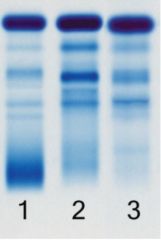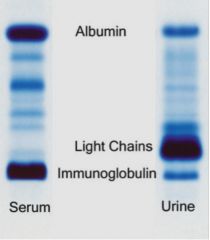![]()
![]()
![]()
Use LEFT and RIGHT arrow keys to navigate between flashcards;
Use UP and DOWN arrow keys to flip the card;
H to show hint;
A reads text to speech;
9 Cards in this Set
- Front
- Back
|
•Know the methods to quantitate and
fractionate proteins particularly protein electrophoresis. |
•turbidimetry,
•colorimetry, •absorption spectrophotometry, •dye binding, •column chromatography, •electrophoresis, •and immunoassays. |
|
|
The major proteins in plasma that contribute to the electrophoretic pattern
|
albumin, α1-antitrypsin, α2-macroglobulin, haptoglobin, β-lipoprotein, transferrin, complement C3, fibrinogen, and
immunoglobulins. |
|
|
how are ceruloplasmin, C-reactive
protein, prealbumin, and protease inhibitors quantified? |
immunoassays.
|
|
|
Hereditary deficiency of what protein causes emphysema?
|
α1-antitrypsin
|
|
|
The major clinical use of serum and urine protein electrophoresis is to
screen for ______ |
monoclonal gammopathies.
|
|
|
The most frequently performed measurement, that
for total protein, is usually performed on serum, which has no ______ and no ________ that may slightly dilute proteins in plasma. |
fibrinogen
anticoagulant |
|
|
__________ separates the globulins from
albumin |
•Protein electrophoresis
|
|
|
(1) chronic inflammation with decreased albumin and increased γ-
globulins; (2) acute inflammation with increased α2-fraction (haptoglobin) and decreased C3 due to activation and consumption of complement; (3) inanition post-spinal cord injury with hypoproteinemia of several fractions. |

?
|
|
|
Describe the Serum and urine protein electrophoretic patterns in a patient with multiple myeloma.
|

Serum demonstrates a predominance of the larger
complete immunoglobulin, while the urine has a large amount of the smaller-sized light chains with only a small amount of the whole immunoglobulin. |

